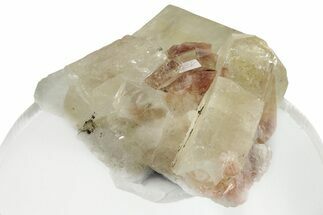This Specimen has been sold.
1.55" Vibrant Blue Azurite Cluster - Australia
This is a striking, .75" blue azurite cluster collected from the Malbunka Copper Mine in the Northern Territory of Australia. It comes from a location famous for flattened, disc-shaped azurite formations called suns, which form between layers of pale kaolinitic siltstone. It has been mounted to an acrylic display base with mineral tack.
About Azurite Suns
Azurite is a vivid, deep-blue copper carbonate mineral best known for forming in the oxidized zones of copper deposits. Among its rarest and most iconic occurrences are Azurite Suns—perfectly flat, radiating crystal discs found only at the Malbunka Copper Mine in Australia’s remote Northern Territory. These striking “suns” sit within chalk-white layers of kaolinite clay, creating a dramatic contrast that highlights their rich, midnight-blue color.
Their formation is as unusual as their appearance. Mineral-rich hydrothermal fluids once flowed through narrow bedding planes in the host rock, carrying dissolved copper ions. When these ions encountered carbonate-bearing groundwater within the compact kaolinite layers, azurite began to crystallize. Confined between the clay beds, the crystals had nowhere to grow but outward, spreading laterally in a flat, radiating pattern. Over time, this process produced the circular, sun-like shapes that make Malbunka azurite suns some of the most distinctive mineral specimens on Earth.
Azurite is a vivid, deep-blue copper carbonate mineral best known for forming in the oxidized zones of copper deposits. Among its rarest and most iconic occurrences are Azurite Suns—perfectly flat, radiating crystal discs found only at the Malbunka Copper Mine in Australia’s remote Northern Territory. These striking “suns” sit within chalk-white layers of kaolinite clay, creating a dramatic contrast that highlights their rich, midnight-blue color.
Their formation is as unusual as their appearance. Mineral-rich hydrothermal fluids once flowed through narrow bedding planes in the host rock, carrying dissolved copper ions. When these ions encountered carbonate-bearing groundwater within the compact kaolinite layers, azurite began to crystallize. Confined between the clay beds, the crystals had nowhere to grow but outward, spreading laterally in a flat, radiating pattern. Over time, this process produced the circular, sun-like shapes that make Malbunka azurite suns some of the most distinctive mineral specimens on Earth.
About Azurite
Azurite is a copper carbonate hydroxide mineral best known for its beautiful and vibrant blue appearance. Azurite typically forms in nodular formations with other colorful, copper-rich minerals. It is a secondary mineral that precipitated in pores, crevices, and caverns from water with high concentrations of carbon dioxide.
Azurite and malachite are known to form in union with each other since their chemical makeup is very similar. In fact, the presence of more or less water in the location of formation is enough to determine whether an abundance of malachite over azurite, or vise-versa, will accumulate.
Azurite is a copper carbonate hydroxide mineral best known for its beautiful and vibrant blue appearance. Azurite typically forms in nodular formations with other colorful, copper-rich minerals. It is a secondary mineral that precipitated in pores, crevices, and caverns from water with high concentrations of carbon dioxide.
Azurite and malachite are known to form in union with each other since their chemical makeup is very similar. In fact, the presence of more or less water in the location of formation is enough to determine whether an abundance of malachite over azurite, or vise-versa, will accumulate.
SPECIES
Azurite
LOCATION
Malbunka Copper Mine, Gardiner Range, Northern Territory, Australia
SIZE
1.55" wide
CATEGORY
ITEM
#287975
 Reviews
Reviews













